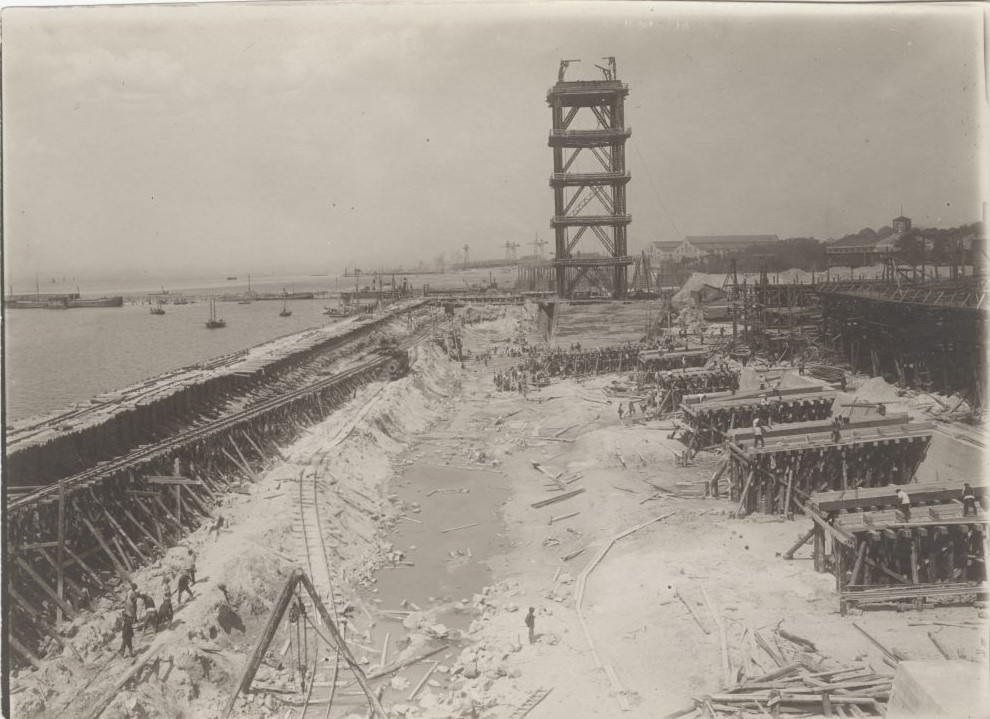
Creation of the Bekker plant complex

Creation of the Bekker plant complex

The necessary research and preliminary work for the construction of the factory was started. The Bekker plant officially began to exist, although construction lasted until 1915. A building for mechanics and turbine workshops, a 121m long and 50m wide 3-stroke building with brick walls, was built.

A shipbuilding workshop building was built 110m long, 60m wide, with four 15m wide blows. It was one of the first large production buildings to be built at the Bekker plant.
A hull marking building was built, a one-storey wooden building with a length of 110 m, a width of 18 m and a height of 3 m

Carpenter workshop was built.

Building of the slip

A boiler workshop was built and the construction of quays began.

A water tower was built, which is located by Kopli Street and secured the water needs of practically the entire peninsula with water from two boreholes. The water tower is over 40.5 m high, with load-bearing reinforced concrete pillars connected by reinforced concrete belts.

A tower crane was installed, which was over 35 m high, with a crane boom reaching 21 m, which ensured a lifting height of up to 30 m. The maximum lifting capacity of the crane was 150 tons.

Large meetings began to take place in the factory every day, and the evacuation of the factory property was discussed. Representatives of Estonian workers wanted to leave some equipment in Tallinn.
The loading of the factory's property on ships and trains began. All the remaining property had to be destroyed according to the secret circulars of the Bolsheviks. Estonian workers at the Bekker factory unloaded assets from the trains, risking their lives, and in the end Tallinn Self-Defense sent 40 rifles and cartridges to the fighters of the Bekker factory. The self-defense fought for every device, it was also helped that the self-defense put coarse sand between the wheel bearings of the circle driving from Kopli to Russia. This measure helped because the camps near Tapa caught fire and the whole train full of the Bekker factory's treasure remained in Estonia.
When the Republic of Estonia was proclaimed, the guarding of workers around the Bekker factory was replaced by a German military guard. During the German occupation, the Bekker factory was subordinated to naval captain von Wolfram.
The Germans began to leave Tallinn, again trying to take whatever was possible, and again the workers of the Bekker factory had to transport fully loaded trains to the sidewalks with the factory equipment, take out locomotives and guard the warehouses.
The Bekker plant was renamed the Northwest Metallurgy and Shipbuilding Plant

The factory was completely stopped.
There were 23 system cannons in warehouse.

Tanks were brought to the Bekker plant, which were cleaned and preserved.
In the summer, drinking water came from just one tap in the entire Bekker settlement, and it was located at the gate of the Bekker factory.
The name of the Bekker factory changed slightly again, Northwest Metallurgy, Mechanics and Shipbuilding Factory.

The Bekker factory was a spare log warehouse for the Auto-Tank division, with 8 cars, 10 trucks, 4 ambulances and 4 motorcycles.

Production began at the Kopli Export Slaughterhouse. The main product was bacon, which was exported mainly to England.
The premises in the Bekker factory were leased to 6 companies, among them AS "Lihaprodukt" with 60 employees, a sausage factory and a slaughterhouse, W. Minkwitz's soap factory with 4 employees, a couple of sawmills.

The port of Bekker was used to export timber.
The port of Bekker officially bore the name of the port of Kopli I. The port had 610 meters of berths, 7246 m2 of warehouses and 700 tons of oil tanks, the water depth in the port was 5.2-5.8 m. In the early years, roundwood and, since the early 1930s, liquid fuel were exported from here.

At the government meeting on 22 May, a decision in principle was taken to dismantle the Bekker crane.

On the evening of October 15, around a quarter to six o'clock, the most decisive works of demolition took place. In the presence of a large crowd, the legs of the giant crane were sawn with acetylene gas and began to sink to the side. According to eyewitness accounts, the rumble of the crane falling was deafening.
There were 4 rowing boats, 2 sailing boats and 2 motor boats registered in this port. As a pride and a kind of symbol of the port of Bekker.
Leningrad warship repair and testing base Tests of ships carrying missiles carrying slip for the repair of warship cannons were carried out at the Bekker plant for Slip Soviet army paratroopers.
Balti Baas AS

OÜ Tallinna Bekkeri Sadam is the port operator with the former business name OÜ Rasmusson.

